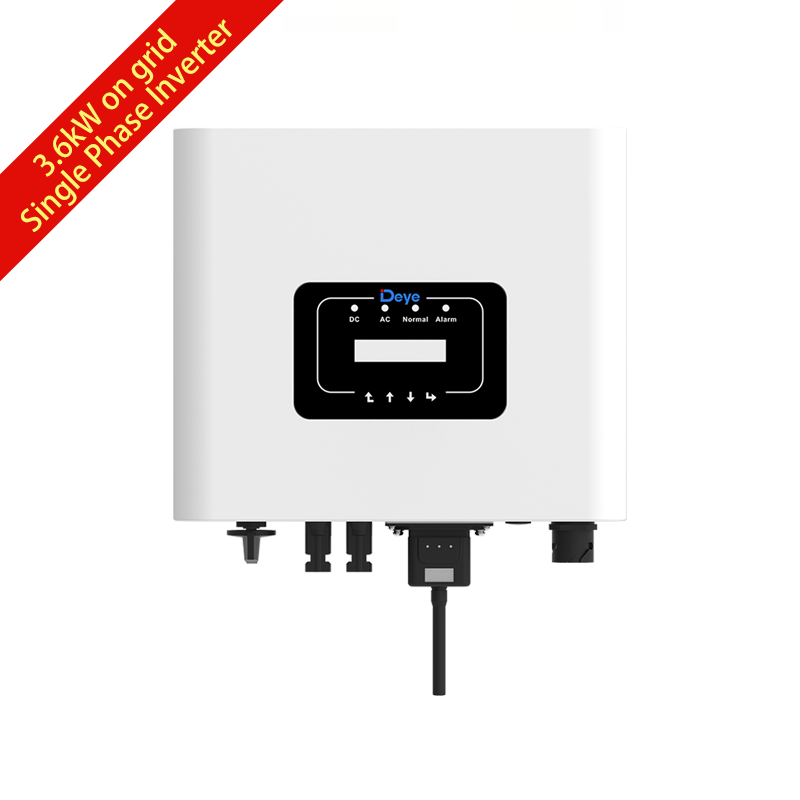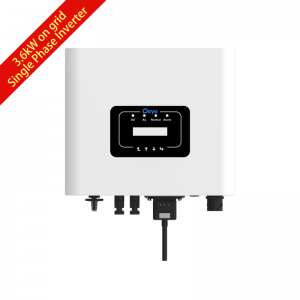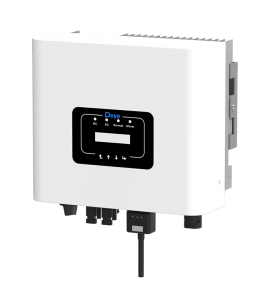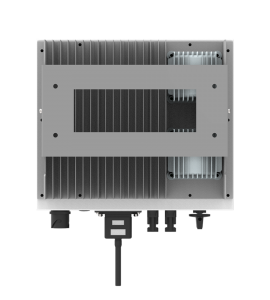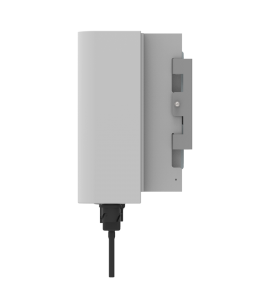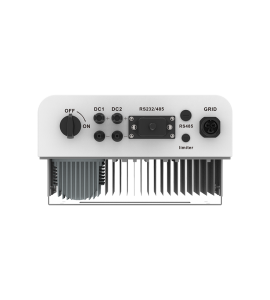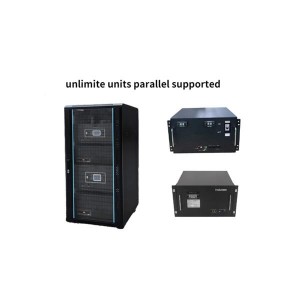

Deye 3.6kW Single Phase On Grid Solar Inverter
ABOUT
Deye 3.6kW Single Phase On Grid Solar Inverter
| Model | SUN-3.6K-G |
| Input Side | |
| Max. DC Input Power(kW) | 4.7 |
| Max. DC Input Voltage (V) | 550 |
| Start-up DC Input Voltage(V) | 80 |
| MPPT Operating Range(V) | 70-550 |
| Max. DC Input Current(A) | 13+13 |
| Max. Short Circuit Current (A) | 19.5+19.5 |
| Number of MPPT/Strings per MPPT | 2/1 |
| Output Side | |
| Rated Output Power(kW) | 3.6 |
| Max. Active Power(kW) | 3.96 |
| Rated AC Grid Voltage(V) | L/N/PE 220 / 230 (optional) |
| AC Grid Voltage Range(V) | 180Vac~300Vac(this may vary with grid standards) |
| Rated Grid Frequency(Hz) | 50 / 60 (Optional) |
| Operating Phase | Single phase |
| Rated AC Grid Output Current(A) | 16.4/15.7 |
| Max. AC Output Current(A) | 18/17.2 |
| Output Power Factor | 0.8 leading to 0.8 lagging |
| Grid Current THD | <3% |
| DC Injection Current(mA) | <0.5% |
| Grid Frequency Range | 47~52 or 57~62 (Optional) |
| Efficiency | |
| Max.Efficiency | 97.30% |
| Euro Efficiency | 97.10% |
| MPPT Efficiency | >99% |
| Protection | |
| DC Reverse-Polarity Protection | Yes |
| AC Short Circuit Protection | Yes |
| AC Output Overcurrent Protection | Yes |
| Output Overvoltage Protection | Yes |
| Insulation Resistance Protection | Yes |
| Ground Fault Monitoring | Yes |
| Abti-islanding Protection | Yes |
| Temperature Protection | Yes |
| Integrated DC Switch | Yes |
| Remote software upload | Yes |
| Remote change of operating parameters | Yes |
| Surge protection | DC Type II / AC Type II |
| General Data | |
| Size(mm) | 330W×323H×190D |
| Weight(kg) | 7.5 |
| Topology | Transformerless |
| Internal Consumption | <1W(Night) |
| Running Temperature | -25~65℃,>45℃ derating |
| Ingress Protection | IP65 |
| Noise Emission(Typical) | <35 dB |
| Cooling Concept | Natural cooling |
| Max. Operating Altitude Without Derating | 2000m |
| Designed Lifetime | 5years |
| Grid Connection Standard | VDE4105, IEC61727/62116, VDE0126, AS4777.2, CEI 0 21, EN50549-1, G98, G99, C10-11, UNE217002, NBR16149/NBR16150 |
| Operating Surroundings Humidity | 0-100% |
| Safety EMC/Standard | IEC/EN 61000-6-1/2/3/4, IEC/EN 62109-1, IEC/EN 62109-2 |
| Features | |
| DC Connection | MC-4 mateable |
| AC Connection | IP65 rated plug |
| Display | LCD 1602 |
| Interface | RS485/RS232/Wifi/LAN |
Energy is the material basis for human survival and activities, and the blood of modern industrialized society. With the progress of industry, human's demand for energy is increasing day by day. Under the background of energy shortage, photovoltaic power generation has attracted extensive attention due to its advantages such as renewable, green, widely distributed, and does not require long-distance transmission.
There are many ways to classify the topology of photovoltaic grid-connected inverters: according to the nature of the DC side, it can be divided into voltage-type inverters and current-type inverters; according to the number of AC voltage phases, it can be divided into single-phase grid-connected inverters and three-phase According to the type of isolation, it can be divided into transformerless isolation, with power frequency transformer isolation and with high frequency transformer isolation; according to the number of power conversion stages, it can be divided into single-stage, two-stage and multi-stage inverters.
The above types of inverters adopt different topological structures according to different application occasions. In this paper, single-phase, two-stage, transformerless, and voltage source inverters are selected for introduction. The front stage is a DC/DC converter, which mainly completes the maximum power tracking, and the rear stage DC/AC converter completes the inverter grid connection. Its circuit topology is as follows:

According to the working principle of photovoltaic cells, photovoltaic cells can be equivalently shown in the figure below. The model is composed of ideal current source Iph, junction capacitance Cd, antiparallel diode D, series resistance Rs and parallel resistance Rsh. The current Iph of the ideal current source is the short-circuit current of the battery, and its magnitude is affected by the intensity of sunlight and the ambient temperature.
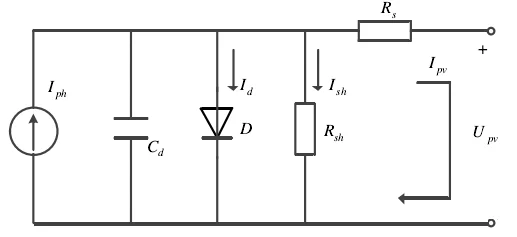
The output characteristic curve of photovoltaic cells is nonlinear, and the characteristics change with the change of light and temperature. Therefore, it is necessary to track the maximum power point of the photovoltaic cell in real time so that it can output energy to the maximum under different loads and external environments. This is the maximum power tracking algorithm (MPPT).
